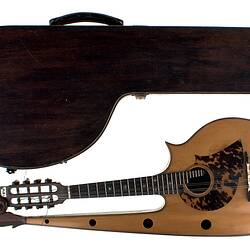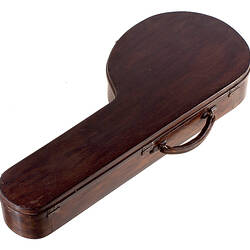Summary
This mandolin created by Giovanni Cera in Melbourne during the 1940s demonstrates an intriguing mix of conventional influences, recycled elements and unusual departures from standard mandolin design.
This is a mandolin with inspiration in its design taken from the Gibson F model instruments, but with a unique, individual approach. The treble side body points are very close to those on a F style Gibson, but the rest is quite different. The soundboard is spruce of some kind, most likely Sitka spruce - Picea sitchensis - as that would have been available for the aircraft industry (propellers were often made from it) at that time. The back, sides and neck look like Queensland Walnut - Endiandra palmerstonii - which would fit in with the story of using recycled furniture as raw material (I can't see how the instrument could have reused parts from an upright bass). The finger board is made from ebony, as is the bridge, which has been shimmed with veneers at some stage.
The unusual aspect of this instrument is the extension of the bass side of the body. This would change the tonal characteristics of the instrument, and it is hard to understand the thinking behind it. The soundboard has been carved from a single piece of timber, which would have started around 13mm thick. This is shallower than a Gibson, which would typically have an arching height of 15mm, and is carved with no 'recurve', a concave area just in from the edges. The bass side extension has been carved proud of the edge to about the same height as the centre of the soundboard. The carved scroll at each end is suggestive of the Gibson style, but in the wrong place. The body is 235mm wide at the bridge and the body has a fairly consistent depth at the edge of 46mm (including the soundboard and back). The neck is set at a shallow angle of around 1° backwards, where Gibson were at a steeper angle of up to 4.5°. This low angle requires the use of a low bridge of around 12-13mm. The bridge has the appearance of a Gibson bridge from the 1903-05 period with its complex carving. The fingerboard might well have been recycled from a damaged or broken Gibson mandolin, as it uses the Gibson 13.875" /352mm scale length rather than the 13" /330mm scale I would have expected an Italian craftsman to have used. The staircase shape of the upper end of the fingerboard also suggests a Gibson origin. The fingerboard is 27mm wide at the nut and 40mm wide at the 12th fret, which would have allowed for celluloid binding to have originally been attached.
The tuners are common side mount type, probably of Italian or German origin. The soundboard binding in 1x2mm rosewood, outside BWBW purfling, which looks as if it is made from BWB violin purfling with a slightly wider extra white (holly or similar) strip. This is a competently made mandolin, which would seem to be playable condition. There are no obvious seam separations although there is one small crack or maybe timber fault, on the back.
More Information
-
Keywords
-
Authors
-
Article types



